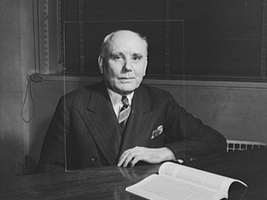
Labor organizer Van Amberg Bittner (March 20, 1885-July 19, 1949) was one of the United Mine Workers of America’s most durable infighters for nearly 40 years beginning in 1911. A John L. Lewis loyalist, Bittner began his UMWA career as a local president in his home state of Pennsylvania. In northern West Virginia, he oversaw unsuccessful organizing strikes and led resistance to unionized operators’ abrogation of their union contracts in 1924–25. He briefly organized miners on Scotts Run near Morgantown in 1931, undercutting the dissident West Virginia Mine Workers Union. Bittner’s major organizing victories in the state came as District 17 president, capitalizing on the protections offered by New Deal labor legislation in 1933 and 1935. These successes made Bittner an influential figure within the state Democratic Party’s New Deal faction.
In 1936, Van Bittner became midwestern director of the Committee on Industrial Organization’s campaign to organize the steel industry, operating from Chicago. He split with Lewis over Lewis’s abandonment of Franklin D. Roosevelt in 1940. Bittner’s position within the CIO was secure, however, and he directed the abortive drive to organize southern industrial workers in 1946. Although Bittner embraced the UMWA policy of racial inclusiveness, his refusal to form alliances with integrationist groups and his rigid antiradicalism undermined the CIO’s organizational unity, probably doing mortal damage to the southern campaign.
This Article was written by John Hennen
Last Revised on September 25, 2012
Related Articles
Sources
Fox, Maier B. United We Stand. Washington: United Mine Workers of America, 1990.
Thomas, Jerry Bruce. An Appalachian New Deal: West Virginia in the Great Depression. Lexington: University Press of Kentucky, 1998.
Zieger, Robert H. The CIO, 1935-1955. Chapel Hill: University of North Carolina Press, 1995.
Cite This Article
Hennen, John "Van Bittner." e-WV: The West Virginia Encyclopedia. 25 September 2012. Web. 26 July 2024.


Comments?
There aren't any comments for this article yet.
Click here to read and contribute to the discussion →